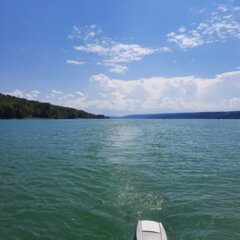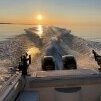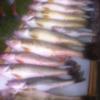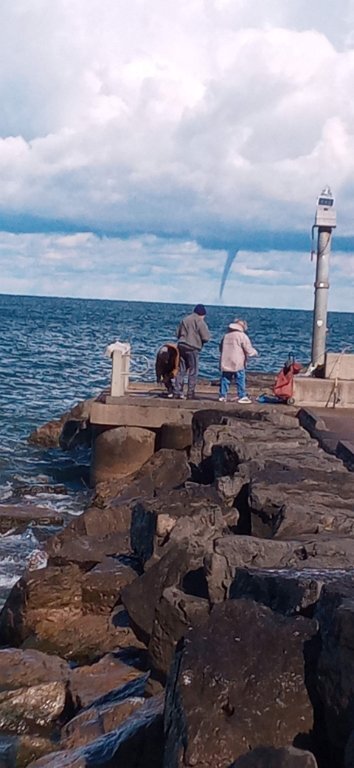

LongLine
Professional-
Posts
3,907 -
Joined
-
Last visited
About LongLine
- Birthday 01/16/1951
Profile Information
-
Gender
Male
-
Location
ROCHESTER NY
-
Interests
FISHING
-
Home Port
Genny
-
Boat Name
LongLine
Recent Profile Visitors
LongLine's Achievements
149
Reputation
-

What's your opinion of the current state of our fishery?
LongLine replied to Yankee Troller's topic in Open Lake Discussion
HB - Don't take that as an insult. Off topic from the subject of this thread, but there's a difference between "actively feeding" and "hitting." Back in the 70's I caught a female while balancing on a rock, 1/3rd of way out the east side of the Oak Orchard channel on a very dismal October evening. (rainy, windy, freaking cold) Casting a CD5 Rapala. Poor cast with a lot of slack. Fish hit it as soon as I reeled in the slack. Never saw fish till it was a couple feet from the rock. Very dark and dropping eggs after I landed her. She had both trebles in her mouth. I thought it was great to catch 28# Salmon feeding under those condition. However, her guts were shriveled up and hard to distinguish which was what. (Totally empty stomach) I then thought that the lure settled directly in front of her, scared her so she grabbed it. Since then, I've seen a lot of underwater videos of spawning fish. Pre and post spawning smallmouth chase anything away from their nests. (Which is why the closed season) I've also seen underwater videos of Salmon runs. In addition to discoloration, hooked jaws and deformed bodies, I've noticed (in most of them) the frequency of their mouth and gill movement. Spawning is very stressful and exhausting for Salmon so I can't help thinking these fish are gasping for breath. I.E. Sucking in a lot of water to get more oxygen. Just like any animal's respiration rate increasing when stressed or exhausted. Bottom line: Did that fish take the lure because it landed so close that she instinctively grabbed it. Was she being protective? Did she just suck it in during one of her deep breaths? She was a spawner, hit a lure but definitely was not "actively feeding." -

What's your opinion of the current state of our fishery?
LongLine replied to Yankee Troller's topic in Open Lake Discussion
-

What's your opinion of the current state of our fishery?
LongLine replied to Yankee Troller's topic in Open Lake Discussion
I agree with Whaler but note regulations can change every year. I'm sure many members remember when the Salomine limit was 5 and not 3 in combination with only 2 Stlhd over 21." Also the years before the slot limit on Lakers; and years when the limit on bass was 10" with 6 per day; just to name a few. I don't remember when they initiated the timed closing of the Little Sandy (Oswego) nor when they initiated the section of the SR to fly fishing only. I really don't see why a new one of a "max length slot" type one can't be initiated in the General Lake Ontario and Tributary regulation section. (I.E. Harvest one King over "X" length per angler per day) According to the 2022 angler surveys: 51,864 Kings were harvested by boats over 169 days, (5+ months) yet 30,968 Kings were caught in the SR in the month of October alone. We don't know how many of the boat caught fish would have gone to the SR but we do know the benefit of Pen rearing regarding returns and according to same report, 62% of those boat caught Kings were on the west end. We also do know that the 30,968 Kings were in the SR at spawning time. As to enforcement, what keeps anyone within the laws? Actually getting caught? The threat of getting caught? Upbringing as a "law abiding" citizen? Knowing that DEC is counting cars and doing angler surveys? -

What's your opinion of the current state of our fishery?
LongLine replied to Yankee Troller's topic in Open Lake Discussion
Let me 1st say I'm an open water guy. Tried tribs twice in my life. 1st time (early 80's) I saw guys snagging huge salmon and thought it was criminal. 2nd time, slipped on my butt & nearly drowned...so scrow that! But I'm also a Data guy. It's not a matter of what I'd like to believe. As to the Sandy Pens, someone contributed the size issue to discontinuing those pens yet here is the data from the Chinooks measured at the SR over years: Pens were at Sandy Creek in 2017. Size decline showed up well before 2017. Here are the pen numbers from 2017 report: As to why they discontinued pens there, published strategy was that they wanted to spread them out more based on the tagging/marking studies that Chinooks caught in the open water could have originated from anywhere and to spread out the trib runs somewhat evenly across all 4 regions of Big-O. They also did away with Little Sodus (Fair Haven) Sodus and 12 Mile. Here's the numbers for the 2022 stocking: (note they increased the numbers in the pens and did away with the direct stocking. They did have a small surplus but unknown where they went) As to closing the river, I'm not against that however, it's not going to happen. Angler survey estimated 870,000 effort hours spent on the open water in a whole season and 747,000 on the SR. On the SR, 373,000 hours from shore estimated to occur during the month of October. That'd be a lot of pizzed off trib guys and a lot of potential economic loss for the east end. As proposed before, I'm all in favor of some kind of daily max length per angler for open water and tribs. I.E. keep only 1 over a certain length per angler. I don't know how that affects tournaments (But don't they require all legal fish must count in box?) Maybee some tourney guys can chime in on their rules? There's no doubt in my mind that Pen Rearing helps survival and growth so here's an "off the wall" idea. I believe the DEC and OMNR coordinate efforts (sometimes "friendly" competition). Could a deal be made where some of the Chinook SF in our pens are Canadian SF? Maybe 10% or so in each pen? Maybe over a few years? -

What's your opinion of the current state of our fishery?
LongLine replied to Yankee Troller's topic in Open Lake Discussion
Per the 2017 L.O. annual report: On 4/21/17 64,000 Chinooks were put in pens on Sandy Cr at 113/Lb (4g) at 50F temperature. They were released on 4/27/17 at 4g weight. (6 days) Per the 2022 L.O. report: On 4/13/22, 18,800 Atlantic Ylg and on 4/15/22, 17,000 Rainbows Ylg were direct stocked at Sandy Creek. Given the short pen-time in 2017 for Chinook SF and that Atlantics Ylg & Rainbows Ylg were stocked there in 2022, I'd guess that Sandy Creek is believed to currently have a temperature regime that is not as conducive to Chinook survival as other sites. I read somewhere that the mortality rate for Chinooks of that size greatly increases about 52-53F. -

What's your opinion of the current state of our fishery?
LongLine replied to Yankee Troller's topic in Open Lake Discussion
There appears to be a definite weight difference between Pen reared US vs Canadian Chinooks. Looking at the historical weights shown in the 2022 LO Annual report for 2010-2016: Very plausible stream conditions are different which would cause this. I.E. Flow, oxygen content, nutrients, temperature regime. There appears to be a difference in stream productivity (conduciveness to growth in pens) on the US side. Again, browsing the 2022 annual report: Then, doing some rough calculations shows fish in Oswego pens grew more, averaged daily, than fish at Oak Orchard, even though they were in pens longer at the Oak. (Converting dates to Julian dates) Typical time in pens at Black, Oswego, Genny and 18 mile was 3 weeks. Oak time was 41/2 weeks. Overall weight gain was comparable at the Niagara; however, they were in the pens for 5 weeks. As stated earlier, from the report on straying where Pen reared fish tend to return to their original pen areas, (2017 annual report) might this explain why bigger fish are caught in the fall towards Oswego/Mexico? I.E. bigger when young, the bigger as adults? The OMNR weights and catch reports seem to add to that theory? Water temperature has to play an important part of fish survival. AS JM1984 stated "had to release a bit early due to temperature..." Don't know the temperature regimes of other places but historical USGS monitoring at Ford Street (Genny) shows variation however typically on 1 April it's low 40's then beginning week of May it starts to climb fairly rapidly thru the 50's& low 60's. Release temps aren't shown in the annual report. Another interesting item from table 2 above is the size of the SR fish released at the Lighthouse. If we say they were initially the same weight as the average weight of the pen reared ones (3.3g) and then start on the average Julian date as the fish were put it pens (day 103), why did they only weigh 7g when released? This was 58 days. It's kind of hard for me to accept that the SR & water fed to the hatchery is not as productive as pen sites. -

What's your opinion of the current state of our fishery?
LongLine replied to Yankee Troller's topic in Open Lake Discussion
-

What's your opinion of the current state of our fishery?
LongLine replied to Yankee Troller's topic in Open Lake Discussion
-

What's your opinion of the current state of our fishery?
LongLine replied to Yankee Troller's topic in Open Lake Discussion
"Evolution" may explain what's happen to salmon world- wide but doesn't explain reported differences between US and Canadian Kings. The problem with research is that for every question answered, many more questions spring up. Browsing thru the 2017 L.O. Annual report (Sec.3) there is significantly greater straying by direct stocked Kings than by pen reared Kings. Direct stocked greatly returned to the SR, although some Pen reared did. The objective of the pen rearing is to get the kings to return to those pen sites. In same publication (Sec.1 A-13) there is a table showing the weights of the pen reared kings for a number of years. From 2005-2016 the average weight of DEC SF pen reared kings was 6.2g. For same years, OMNR SF pen reared was 7.7g. (24% bigger) Browsing the 2022 L.O. Annual report: Almost 600K SF Kings (DEC) were pen reared out of 904K Kings stocked. The average weight calculated to 6.9g. The questions I have include: Does this weight difference explain some of the weight differences reported as adult fish? Why is there a weight difference between DEC & OMNR SF fish? Should the SF Kings be kept at hatchery or in the pens a little longer? -

What's your opinion of the current state of our fishery?
LongLine replied to Yankee Troller's topic in Open Lake Discussion
If you look at the 2022 DEC L.O. Annual report under Characteristics of the salmon run on the SR, they note the Chinook run consisted of 54% 3 yr olds and 39% 2 yr olds. Although they calculated 4 yr olds to be only 1%, there are no physical measurements of any 4 yr old. Back in the 80-90's there were up to 10% 4 yr olds. So, to Yank's point: yes, eggs & milt should only be taken from the largest fish and IMO something should be done to protect some of the larger ones. -

What's your opinion of the current state of our fishery?
LongLine replied to Yankee Troller's topic in Open Lake Discussion
Yep. DEC data shows they're getting smaller. Grab a couple beers and read thru this: Recent declines in salmon body size impact ecosystems and fisheries | Nature Communications If you make it thru that and want more just google: "salmon maturity trends." You'll see that it's happening to all salmon specie world-wide but most drastically on Chinooks. -

What's your opinion of the current state of our fishery?
LongLine replied to Yankee Troller's topic in Open Lake Discussion
I got the general feeling that the majority of fishermen prefer the larger Chinooks. The object is to help protect the larger fish so they can return to the rivers. Theory being that larger fish produce larger offspring. The regulation I would propose is in addition to the existing individual daily 3 in combination rule. It would apply to both Open water and Tribs. All Derbies/tournaments require that only legal fish be entered. I picked 33" as that's a little longer than the typical 3 yr old return at the SR. (maybe should be 34" ?) -

What's your opinion of the current state of our fishery?
LongLine replied to Yankee Troller's topic in Open Lake Discussion
I can accept the density/size correlation for some fish. The smallmouth population took a major dive a few years ago (thanks to gobies and birds) and fewer smallmouths are caught today but are much bigger than before the dive. Also, I remember years ago the pike population in I-bay took a dive and the bay became crowed with small perch. Now, most pike, if caught, there are in the 10-15 Lb class and perch have been reported as getting bigger. However, these fish are basically "home bodies." I.E. they inhabit a certain area. Chinooks are known as pelagic wanderers and not "home bodies." So, I'm not sure the same correlation holds true for them. Smaller Chinooks are spawning on the west coast also. It's my understanding that the Chinook favorite alewife are relatively poor swimmers whose general movement is from deep to shallow water and back again. I'm not aware of any great east-west movement for them like Chinooks. (Please correct me if that's wrong) I'm not a "fish psychologist" but my question is why would an Oswego Chinook swim to Toronto when there's plenty of easy food, much closer, along the south shore to eat? He's been called an "eating machine." Alewife numbers seem to be rebounding. Years ago, the gov't instituted a slot limit on Lakers to protect their spawners. They lowered the limit on Steelhead/Rainbows to protect the specie. There is a minimum size limit of Chinooks and Steelhead/Rainbows. I don't see any reason they can't institute some kind of maximum size limit on Chinooks, for both open water & tribs, even if only on an experimental basis. I.E. Can only harvest one over 33". -

What's your opinion of the current state of our fishery?
LongLine replied to Yankee Troller's topic in Open Lake Discussion
Looking at the 3 LOC's, there's only one over 30 and that was 31. Genetic potential and genetic reality are two different things. For years there has been a downward trend in the length of 3 yr olds per DEC. Something is stunting their growth. This is also happening on the west coast. Proteins are great for building muscle mass, but I've never seen anything to say they make one taller/longer. But the big question to me is why are the reaching sexual maturity at a younger age? -










